Lord Siva is one of the principal deities of Hinduism. Shiva is known as “The Destroyer” within the Trimurthi (the triple deity) of supreme divinity that includes Brahma and Vishnu. Lord Shiva is the primal Atman (self) of the Universe.
“Om Namah Sivaya” is one of the most popular Mantras and means “adoration to Lord Siva”. It is called “Siva Panchaksharam” meaning the “five-syllable” mantra (excluding the Om).
The five syllables – “Na | Ma | Si | Va | Ya” indicate the five elements – Earth, Water, Fire, Air, and Ether (or Sky). These five elements are the building blocks of everything in Creation, including the human body. Lord Siva is worshipped as the presiding deity of the five elements of Nature.
Five temples are dedicated to Lord Siva each representing a manifestation of the five prime elements of nature.
Pancha (Five) Bhoota (Elements) Sthalam (Place) are located in South India, four temples in Tamil Nadu, and one in Andhra Pradesh.
Each temple has a unique story to tell with a distinct spiritual essence and the significance of worldliness.
Today, I will share the story of these pancha bhootha sthalangals that I have learned through my parents and through scriptures. Hope you get an opportunity to visit these temples someday and learn the history, experience the beauty and richness in their architecture and sculptures.
- Ekambareshwarar Temple
- Jambukeshwarar Temple
- Annamalaiyar Temple
- Kalahasteeshwarar Temple
- Thillai Natarajar Temple
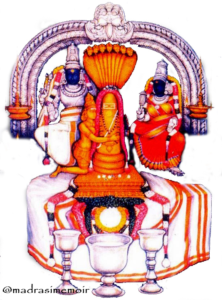 Temple: Ekambareshwarar Temple
Temple: Ekambareshwarar TemplePresiding Deity: Ekambareshwar
Location: Kanchipuram
Lingam: Prithvi Lingam
Element: Earth
The Story of Prithvi Lingam
Once upon a time, Goddess Parvathi covered Siva’s eyes, and the world suddenly filled with darkness. With Siva’s eyes closed, the Sun and Moon darkened without even a beam of light. Siva opened his third eye and saved the day for mankind.
Parvathi was filled with guilt after witnessing all these. Siva asked her to do penance to free her from wrong karma.
Parvati was born on earth as “Kamakshi” and started her penance. She made a Siva Linga out of the sand and worshipped Lord Siva in the form of “Prithvi Lingam” (lingam made of earth) under a mango tree.
Siva in order to test her devotion caused a flood where Kamakshi was busy worshipping him. Kamakshi on realizing about the flood got scared of the Prithvi Lingam being washed off, embraces the lingam.
Lord Siva who literally started melting due to her devotion and love appears in his materialized human form and marries Kamakshi.
Moral of the Story:
Your actions and reactions are on you. You are accountable for every word and action you put out. Do what makes you happy without hurting others.
Interesting Facts:
- The lingam at this temple is made and worshipped by Goddess Parvathi herself. Kamakshi accidentally left her bangles marks on the lingam when she embraced the lingam which can be seen even today.
- Even today, to prevent the sand-made Shiva Lingam from deteriorating, the Abhishekam is done with Jasmine oil.
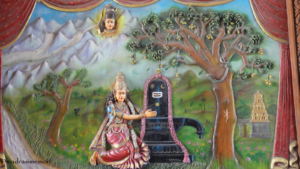
- The “Sthala Vriksham” (Monumental Tree) mango tree is more than 3500 years old and yields four different flavors of mango.
Architectural Facts:
- This temple has an “Aayiram Kaal Mandapam” (1000 pillared hall), 1008 Siva Lingams that adorn the inner walls of the temple, and the ten musical pillars at the inner corridor of the temple.
- This temple is the tenth-largest temple in India, spread over 23 acres.
- Having been in existence since at least 600 AD and is one of the most ancient temples in India.
- Another architectural brilliance is that the sun rays fall directly on the Siva linga every 19, 20, and 21 of the Panguni month (March-April) which is when the most important festival of the Ekambareswarar Temple is celebrated, the Panguni Uthiram.
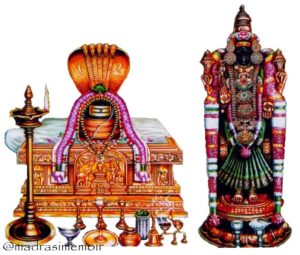 Temple: Jambukeshwarar Temple
Temple: Jambukeshwarar TemplePresiding Deity: Jambukeshwarar - Akhilandeshwari
Location: Thiruvanaikaval (Trichy)
Lingam: Appu Lingam
Element: Water
The Story of Appu Lingam:
Once upon a time, Goddess Parvathi mocked the penance of Lord Siva for world betterment. Siva decided to condemn her behavior and ordered her to go to earth to do penance. Parvathi finds the Jambu forest to conduct her penance in the form of “Akhilandeshwari”. She makes a Lingam under the Venn Naaval tree (Jambu tree) out of the water from the Cauvery River and begins to worship. The lingam is called “Appu” Lingam.
Lord Siva finally appears in front of her and teaches her the “Siva Gnana” (the ultimate knowledge by Lord Siva). Akhilandeshwari received lessons from Siva facing North, who stood facing West.
Moral of the Story:
Put yourself in others shoes before you mock them. There might just be more to the story than you realize.
The Story behind the name "Thiru Aanai Kaa":
Once upon a time, there were two Siva Ganas (followers) named “Malyavan” and “Pushpadanta”. Even though they both are Siva Ganas, they quarrel with each other and fight over one thing or another. On one such fight, “Malyavan” curses “Pushpadanta” to become an elephant on earth, and “Puspadanta” cursed “Malyavan” to become a spider on earth. Both the elephant and the spider came to “Jambukeshwaram” and started to worship Lord Siva.
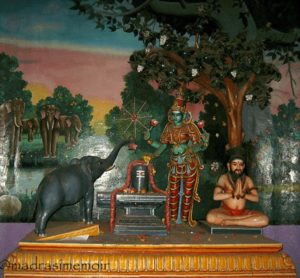
The elephant gathered water from the Cauvery River and performed regular ablution to the Lingam under the Jambu Tree. The spider built its web over the Lingam to avoid the dropping of dry leaves and sunlight from falling directly on the Lingam. The elephant while pouring the water would rip the web and wash the lingam and the cycle continued every day.
One day the Spider got angry and decided to find out who was ripping its web. When the spider saw the elephant do it, it crawls into the elephant’s trunk, biting the elephant to death and killing itself.
Lord Siva moved by the two’s deep devotion, relieved them from the curse. This place came to be known as “Thiru Aanai Kaa” as the elephant worshipped Siva here.
As a result of committing a sin by killing the elephant, the spider was born as the King “kochengat” Chola in the next birth and built 70 temples and this temple is one of them.
Moral of the Story:
Do everything you have to do but not with greed, not with ego, not with envy but with love, compassion, humility and devotion.
Interesting Facts:
- In the shrine of the temple, a stream of water flows under the Lingam that never dries up.
- As Lord Shiva and Goddess Parvathi (Akhilandeshwari) share a Guru and Disciple relationship in this temple, the Shivarathri celebrations of the Wedding of Lord Siva and Goddess Parvathi is not performed in this temple, and the idols in the temple are installed opposite each other.
- During the Uchi Kala Pooja (Prayers performed at noon) which is conducted every afternoon, the priest dresses up like a woman in saree and performs the Abhishekam as a symbolic depiction of Goddess Akilandehswari’s worship.
Architectural Facts:
- Kochengat Chola remembering his previous birth and enmity with the elephant constructed the Siva Sannadhi (sanctum) so small that no elephant can enter. The entrance to the Sanctum is only 4 feet high and 2.5 feet long.
- The temple is around 2500 years old and is the thirteenth largest temple in India, spread over 18 acres.
- The temple has five Prakarams (enclosures) and the fifth prakaram known as “Vibudi Prakaram” stretches over a mile and is two feet thick and over 25 feet high. It is believed that Lord Siva himself built the wall.
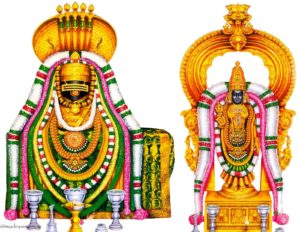 Temple: Annamalaiyar Temple
Temple: Annamalaiyar TemplePresiding Deity: Annamalaiyar (Arunachaleswarar) – Unnamalai Amman (Apitakuchambal)
Location: Thiruvannamalai
Lingam: Agni Lingam
Element: Fire
The Story of Ligothbava
Once upon a time, when Lord Vishnu and Lord Brahma contested for superiority, Lord Siva manifested himself in the form of a massive column of fire and challenged Them to find His Source (the crown and the feet) and whoever finds the source would be greater than the other.
Lord Brahma took the form of a swan and flew up towards the sky to see the top of the flame, while Lord Vishnu became a boar and went downwards. (This is referred to as Lingothbava).
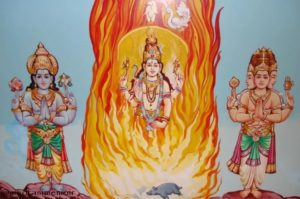
After several days of travel Vishnu could not find the feet of Lord Siva so he conceded his defeat, sat in deep meditation, and realized that he is not the greatest.
Brahma also traveled several days and could not see the head. While he was planning to return, he saw a flower (“Thazhampoo”) coming down. Brahma enquired the flower where it is coming from and the flower said it is coming from the head of Lord Siva. Brahma requested the flower to give evidence in his favor that he has seen the pinnacle.
Brahma and the flower told Lord Vishnu that he has seen the head of Lord Siva. Immediately Lord Siva appeared and was very angry with Lord Brahma and Thazhampoo for telling lie. In punishment, Lord Siva ordained that Brahma would never have temples on Earth in his worship and the Thazhampoo will never be used to worship Lord Siva in any temple. The flower pleaded for forgiveness and Lord Siva made a concession that the flower may be used only on the Maha Siva Rathiri nights.
Moral of the Story:
Head weight and Ego create an Attitude that vacuous you.
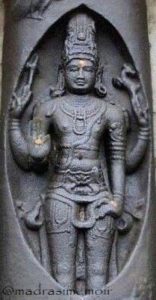
Interesting Facts:
- A celebration of this manifestation is seen today in the age-old traditions observed in the Maha Siva Rathri and Karthikai Deepam Utsavams held here.
- The Tamil Saint Poet Arunagirinathar began composing his immortal work “Thirupugazh” at this temple.
- The history of this temple dates back thousands of years and has been mentioned in sacred Tamil Scriptures.
- Every full moon, thousands of pilgrims perform the “Girivalam” which is a form of worship done by the circumambulation of the Arunachala (Thiruvannamalai) hill. This is a 14-km long walk.
Architectural Facts:
- This temple is said to be the eighth largest temple in India, it uses all its 24 acres area completely for religious purposes.
- The temple has four Gopurams, one on each side. The highest of these is called “Rajagopuram” which is 217 feet in height and is the third-largest in India.
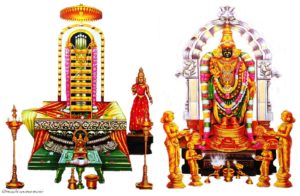 Temple: Kalahasteeshwarar Temple
Temple: Kalahasteeshwarar TemplePresiding Deity: Kalahasteeswarar – SriGnanaprasunambika Devi
Location: Sri Kalahasti
Lingam: Karpoora Vayu Lingam
Element: Air
Vayu Deva and Karpoora Lingam
During the early days of creation, Vayu (the Lord of Air/Wind) performed penance for thousands of years to “Karpoora Lingam” (Karpoora means camphor).
Pleased with his penance, Lord Siva manifested before Vayu and said, “O Vayu Deva! Though you are dynamic in nature, you stayed here without movement and did penance for me. I’m pleased with your devotion. I shall grant you three boons”.
Vayu said, “Lord, I want to be present everywhere in this world. I want to be an integral part of every Jeeva (Soul). I want to name this Karpoora Lingam, which represents you, after me”.
Lord Siva said “You are qualified for these three boons. As per your wish, you will be spread throughout this world. Without you, there will be no life. This linga of mine will forever be known by your name Karpoora “Vayu” lingam.”
Moral of the Story:
To succeed in your mission, you must have single-minded devotion to your goal.
The story of Sri Kalahasti
Srikalahasti got its name because of the great devotion of a spider (sri), serpent (kala), and elephant (hasti) to Lord Siva.
A spider weaved its web around the Lingam to prevent it from dust and leaves. One day a fire was caused to destroy the spider’s offerings. The spider became angry and was about to gulp down the flame, endangering its life. Lord Siva appreciated its devotion and appeared before the Spider and granted the spider a boon. The spider requested moksha (release from the cycle of births and deaths). Lord Siva granted the boon and the spider became one with Siva.
During a different phase, a cobra (snake) worshipped Lord Siva by offering rare gems to the Lingam. After the snake had worshiped, an elephant came to worship Lord Siva. In preparation it sprayed the Lingam with water from its trunk, scattering the gems. Then it proceeded to decorate the Lingam with Flowers and Leaves from the holy trees. When the Cobra returned, it was angered to see it disrespected and replaced with flowers & leaves. The Cobra would replace the flowers with gems.
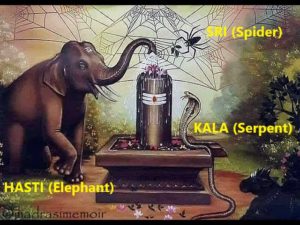
This charade repeated itself every day until the Cobra became fed up and decided to punish whoever was destroying its offerings. When the elephant returned to worship the cobra slithered up its trunk and injected its venom. In agony, the elephant dashed its head on the rock nearby. The elephant died succumbed to the poison and the snake died due to its wound from the elephant dashing against the rock.
Understanding the love of the Cobra and Elephant and their sacrifice, Lord Siva resurrected them, gave them liberation, and took them into their own body.
Today, you can see a Spider on the foot of the Lingam, two elephant tusks on the Lingam, and the five-headed cobra at the top of the Lingam.
Moral of the Story:
Practice being selfless. You end up getting more than you anticipate when your soul is giving.
Story of Kannappa Nayanaar
Thinnan was born to Nagan, the chief of a hunting tribe near the present-day Srikalahasti. He was born after a lot of penance by his parents and was a very strong boy. Hence he was named Thinnan which means “strong” in the Tamil language. Thinnan became a skillful archer as he grew up.
As Nagan became old, the tribe needed a young strong chief and the tribe elected Thinnan as their next Chief. Thinnan fulfilled his duties well and led the tribe on hunting expeditions.
One fine day as Thinnan and his friends were hunting, Thinnan chased a wild boar and entered the forest where he found the Siva Lingam. He was immediately drawn to the lingam and found a special bonding with the Lord. He decided to stay back there and cook the boar and offer it to Lord.
Being a hunter, he did not know how to properly worship Lord Siva. Every day Thinnan would go hunting, catch the prey and bring it to Lord Siva. He will fill his mouth with water from the nearby river Swarnamukhi and keep the wildflowers on his matted hair as he would be carrying the meat he hunted in his hands.
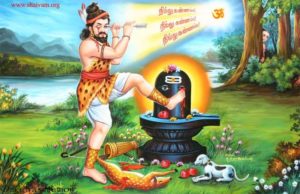
He would spit the water on the Lingam thereby bathing the Lord and would place the meat in front of the lord as his offering. Then he would take the wildflowers from his head and adorn the Lord with them. He will talk to the Lord for a while and then will head back to his tribe.
There was this Siva Kochariyar (sage) who was also a staunch devotee of Lord Siva and who worshipped the same Lingam. The sage would come every day when Thinnan was not there and was aghast at the sight of the meat. He would clean thinking that some animal would have dragged the meat. But as days went by, he was very troubled that the Lord was being desecrated with flesh and bones. He pleaded to the Lord to help him solve this mystery.
Lord Siva appeared in the Siva Kochariyar dream and said it is a devotee of the Lord who is doing this out of his unconditional love for the Lord. And the sage can witness the extent of Thinnan’s devotion by hiding behind the bush the next morning.
The next morning, the sage did as he was told and hid behind a bush. Thinnan came as he does every day with his mouth full of water, flowers in his hair, and meat in his hands. He did the ritual bathing of the Lord, adorned the Lord with flowers, and offered the meat. The sage watched and was horrified.
Thinnan started speaking to the Lord as he always does and suddenly found blood oozing from the left eye of the Lord. Thinnan was shocked. He tried to wipe the blood but it bled more. He ran into the forest and brought some medicinal leaves and crushed them and applied to the Lord’s eye. But the bleeding did not stop. Now Thinnan did the most daring thing, he picked up his arrow and plucked out his left eye. Carefully he placed it on the Lord’s left eye. The bleeding stopped.
Thinnan was very happy however it did not last long. Now he found the other eye oozing blood. He became very sad but he knew the treatment though. He was ready to take out his right eye also but was not sure how he would place it in the right position of Lord’s bleeding eye. He thought for a while and then lifted his leg and placed it in the Lord’s bleeding eye. He prepared to pull out his right eye. The Lord called out “Kannappa Nil Kannappa” (Kannappa halt Kannappa) (Kan = eye in the Tamil Language; Appa = a way of addressing someone in the Tamil Language).
Thinnan’s eyes were restored by the Lord and the Lord appeared before him. Since then Thinnan was known as Kannappa Naayanar. The sage understood the deep-rooted love and devotion of Kannappa.
Moral of the Story:
God accepts only the love with which things are offered to Him.
Interesting Facts:
- The Karpoora Vayu Lingam is white in color and is considered “Swayambu Lingam” (self-manifested lingam)
- The Karpoora Vayu Lingam remains untouched by human hands including the priests.
- The lamp inside the inner sanctum flickers constantly without any air movement. One can observe it even when the priest closes off the entrance to the sanctum which has no windows.
Architectural Facts:
- The initial structure of the temple was constructed in the 5th century, improvements and additions were made during the subsequent years of the Chola Dynasty and the Vijayanagar emperors.
- The temple has an enormous, ancient gopuram over the main gate, which is 36.5 meters (120 feet) high that was built in 1516 AD by the Vijayanagar King Krishnadevaraya. It is considered to be an architectural marvel. Unfortunately, the gopuram collapsed in May 2010 and is currently under renovation.
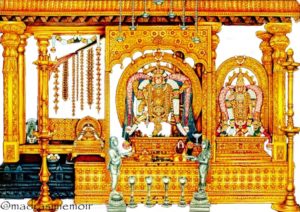 Temple: Thillai Natarajar Temple
Temple: Thillai Natarajar TemplePresiding Deity: Thillai Natarajar (Chidambaranathar) – Sivagamasundari
Location: Chidambaram
Lingam: Akasha Lingam
Element: Ether
Ananda Thandavam
Chidambaram (the town) was once in the midst of the Thillai Vanam (Thillai Trees are a species of mangrove trees and Vanam means forest). In the Thillai Vanam lived a group of sages who believed in the supremacy of magic and that God can be controlled by mantras and rituals.
Lord Siva would stroll in the forest with great beauty and brilliance in the form of Pitchatanadar, a simple mendicant seeking alms. During the stroll, he was followed by his Grace consort “Mohini” who was none other than Lord Vishnu.
The Sages and their wives were enchanted by the beauty and brilliance of the handsome mendicant and his consort. On seeing their womenfolk enchanted, the sages got angry and invoked scores of Serpents by performing magical rituals. Lord Siva the mendicant lifted the Serpents and donned them as ornaments on His matted locks, neck, and waist.
Further enraged, the sages invoked a fierce tiger. However, Lord Siva skinned and donned it as a shawl around his waist.
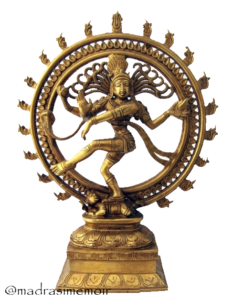
Further frustrated and enraged, the sages gather all their spiritual strength and invoke the powerful demon “Muyalakan” – a symbol of complete arrogance and ignorance. Lord Siva wearing a gentle smile, steps on the demon’s back, immobilized him, and performed the “Ananda Thandavam” (the dance of eternal bliss). This is when Lord Siva discloses his true form. The Sages surrender, realizing the truth. The idol of Nataraja in Chidambaram depicts the deity performing the Ananda Thandavam.
Moral of the Story:
Believe and follow the Truth. No magic, rituals, or other formalities can hide, defeat or destroy the truth.
Interesting Facts:
- The Chidambara Rahasya, or the greatest secret, is said to have originated from this temple. The Chidambara Rahasya depicts the priest unveiling the curtain to an empty space within the inner sanctum of the temple. This symbolizes the removal of the curtain of ignorance to attain the Ultimate Bliss.
- This is the only temple out of the Pancha Bhoota Sthalam where Lord Siva is represented by an anthropomorphic idol rather than the Lingam.
- The temple also worships Lord Siva in the form of a Lingam made out of Crystal and in his formless form (represented by an empty room)
Architectural Facts:
- The temple is the fifth largest temple in India, expanding over a space of 40 acres, located in the heart of the town of Chidambaram.
- The Temple sculptures depicting the “Thillai” trees date back to the 2nd Century CE.
- The Gopuram of the temple carries a gold-plated roof by the Chola King Parantaka.
- Legend has it that the temple is located at the lotus heart of the universe – Virat hridaya padma sthalam.